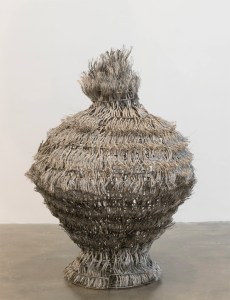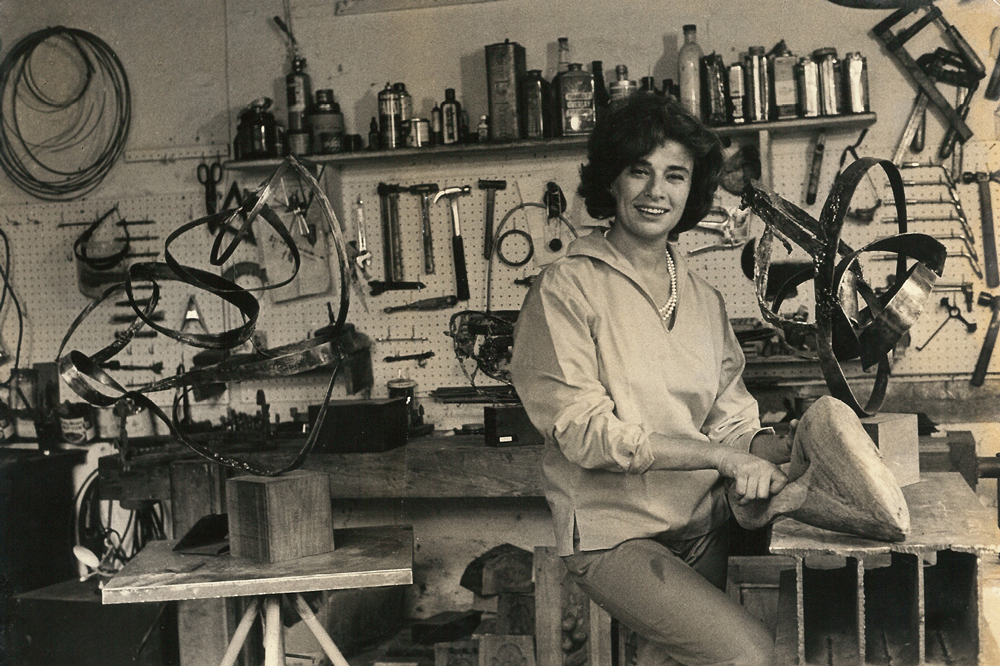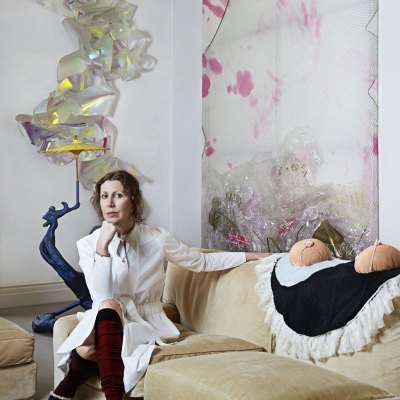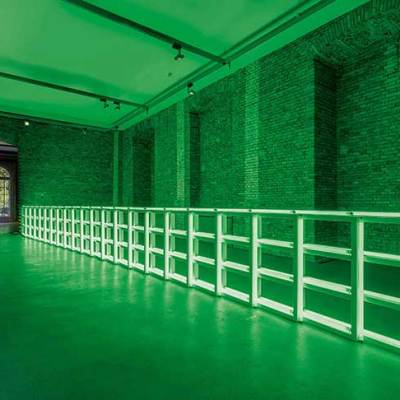‘Making it’ at Waddington Custot draws together a group of women artists who produced abstract sculpture in and around the 1960s and ’70s. Its subtitle, ‘Women and Abstract Sculpture’, avoids implying that the artists, few of whose paths crossed, were bound by any shared political or feminist cause. However the obvious, and still fun, provocations of Lynda Benglis – including a multicoloured splatter of latex on the floor, wryly reminiscent of Pollock’s best efforts – set the tone for a show that gives short shrift to notions of male ‘genius’. The inclusion of Benglis is an anchor among the actions and happenings of the then pivotal New York art scene, but the show is of interest for its considerable geographic spread.
Untitled Vessel (Small Body) (2021), Maren Hassinger. Photo: Adam Reich; courtesy Susan Inglett Gallery

The exhibition makes sense of the artists’ differences by making pointed comparisons between their use of materials. One instance is the placement of Maren Hassinger’s Untitled Vessel (Small Body) (2021), a shimmering urn amassed from withering steel wire ropes, beside a pair of small-scale compositions, also in steel, made by Beverly Pepper in 1965. Hassinger began stockpiling her industrial material from junkyards in Los Angeles during the 1970s, and found it to be a pliable fibre for twisting into semi-figurative shapes. Her use of these wires calls to mind the compulsive repetitions of Kusama and Eva Hesse in how it too suggests some lineage from the serial forms of minimalism. By contrast, the brutal materiality and stark silhouettes of Pepper’s wrecked scraps have long drawn comparisons to Richard Serra.
Calm Sea (1965), Beverly Pepper. Photo: Maxwell Rivas; courtesy Fondazione Progetti Beverly Pepper and Kayne Griffin

In this context, the inclusion of Greek artist Sophia Vari, represented here with works from 2019 and 2013 in marble and bronze, is puzzling. Where the nature of the material determines the form for so much of the work here, her immaculately curved compositions instead feel derived from earlier influences such as the cubists or Hepworth.
As a substantially older artist who made her name in the 1950s for large painted wood structures, Louise Nevelson also sits outside the conversation. Given her stature, however, Sky City I (1957-59), with its odd array of partially figurative elements, offers some useful historical background for the more radical nature of the practices of the other artists here.
Picking up the baton for work in wood is Mildred Thompson, a Black artist who absented herself from the scene in New York after struggling to achieve recognition. One dealer, noting the discrimination she faced, suggested she might have better luck asking a white friend to take her work around the galleries instead. In 1963, she moved to Germany, where she worked on her wonky, minimalist ‘wood pictures’, which occupy a no-man’s-land between the pictorial and sculptural. On display here instead are long, lyrical standalone works, produced later and vaguely reminiscent of musical instruments.
Mermaid I (1978), Françoise Grossen. Photo: Genevieve Hansen; courtesy the artist and Blum & Poe, Los Angeles and New York; © Françoise Grossen

Much of the gallery is taken over by textile art, which is not unrelated to the gender of the artists. Each of these pieces recall in some way Hesse’s strange inventions, with some suggestion also of Robert Morris’s felt hangings. Mermaid I (1978), a set of weighty hand-knotted ropes collapsed on the floor by Swiss-born artist Françoise Grossen, takes centre stage, while to the side another of her pieces hovers, its messy interlace of natural fibres at once drooping and dilating. Olga de Amaral, who lived and worked in Colombia but made her mark internationally, is represented through monumental wall hangings, of which those dressed in gold leaf immediately catch the eye.
The work of Barbara Levittoux-Swiderska is the greatest revelation here. The Polish artist has used natural and man-made fibres to make large nettings that, though suggestive of everyday fabric, have a distinctly sculptural presence. Fire [Pożar] (1974), placed in its own private annex, certainly merits the honour and easily claims the space.
Fire [Pożar] (1974) Barbara Levittoux-Swiderska. Courtesy Waddington Custot; © The Estate of Barbara Levittoux-Swiderska
![Fire [Pożar] (1974) Barbara Levittoux-Swiderska. Courtesy Waddington Custot; © The Estate of Barbara Levittoux-Swiderska](https://apollo-magazine.com/wp-content/uploads/2021/10/Women-and-Abstract-Sculpture-View-24.jpg?resize=730%2C566)
The show is inspired by a quote from Lucy Lippard’s essay ‘Changing Since Changing’ (1995), in which the critic recalls, ‘in the winter of 1970 I went to a great many women’s studios […] found women in corners of men’s studios, bedrooms, children’s rooms, kitchens’. The memory loses much of its meaning taken out of context, as she continues, ‘I thought American art was large. I found women working small, both out of inclination and necessity.’ Her growing feminist consciousness, she claims, helped her see this and other assumptions as part of her ‘preconditioning’ by the male art world. Gradually she came to appreciate work that was, in form or ideology, specific to women’s experiences and circumstances.
The notion of an inherently female art does, rightly, raise alarm bells. As Lippard cautions, ‘I wince when I hear all the lovely variety of women’s art lumped together as a single entity.’ However, the essay makes a bold case for groupings based on gender, or ‘a separatist art world’, that places women artists only in the context of other women artists, thus freeing them from being held to potentially ill-fitting norms and standards made by and for men. In this way, Lippard contends, we might discover something genuinely new.
‘Making It – Women and Abstract Sculpture’ is at Waddington Custot, London, until 13 November.



